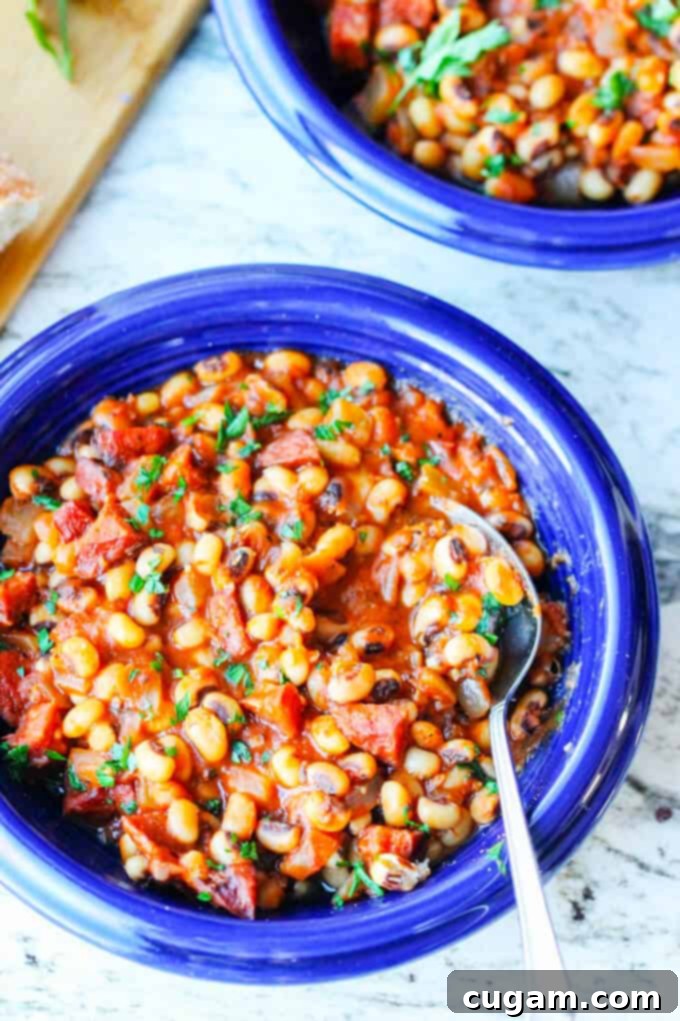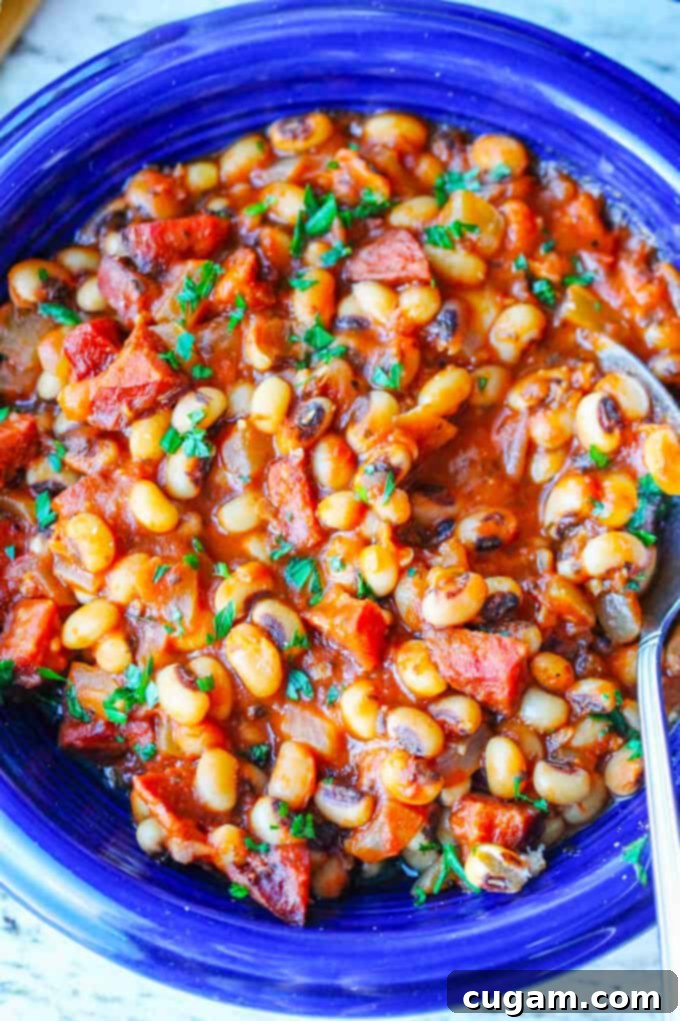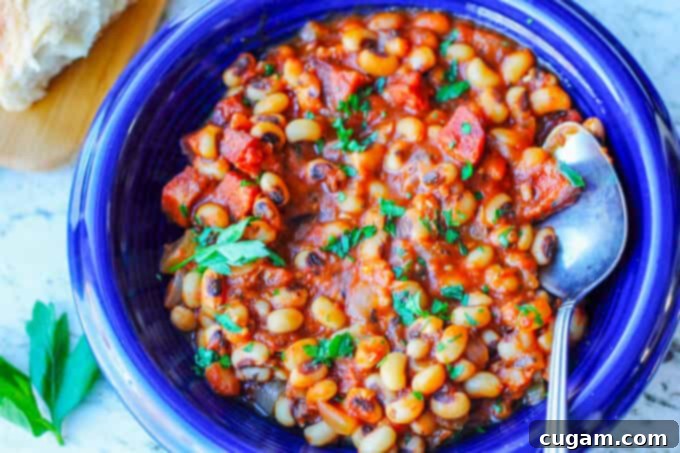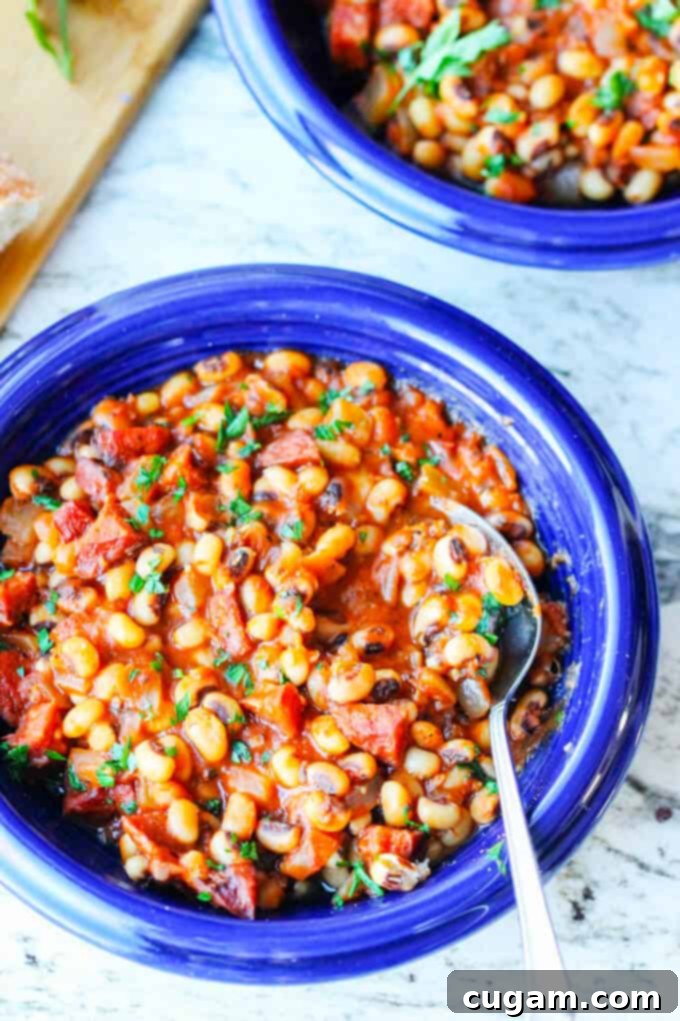Hearty Polish Breton Beans (Fasolka po Bretonsku) with Kielbasa & Tomatoes: A Comforting Classic for Cold Days and New Year’s Luck
There are few dishes as truly comforting and satisfying as a rich, savory bean stew, especially when the weather turns chilly. This recipe for Breton Beans (Fasolka po Bretonsku) with Kielbasa and Tomatoes is an absolute gem, offering a warm embrace during cold winter days. It’s a dish deeply ingrained in Polish culinary tradition, known for its robust flavors and hearty ingredients. And for those looking to start the New Year with a touch of tradition and a sprinkle of luck, using black-eyed peas adds a meaningful twist, believed to bring prosperity for the year ahead.

Unveiling Breton Beans (Fasolka po Bretonsku): A Polish Culinary Treasure
Breton Beans, or as it’s known in Poland, “Fasolka po Bretonsku,” is an immensely popular and beloved dish throughout the country. While its name suggests an origin from Brittany, France, its widespread presence and deep cultural roots in Poland lead many to consider it a traditional Polish dish in its own right. It’s a staple in Polish homes, often served at family gatherings, weekend dinners, or simply as a satisfying meal on any given day. The hearty combination of beans, smoked sausage, and a rich tomato sauce makes it a quintessential example of Polish comfort food.
Over the years, I’ve received numerous requests for more authentic Polish recipes, and this classic Fasolka po Bretonsku is one that truly deserves the spotlight. Its popularity stems not only from its delicious taste but also from its versatility and ease of preparation, making it accessible to home cooks of all skill levels.
Traditionally, Polish Breton Beans are prepared using large white beans. These are typically soaked overnight and then cooked for an hour and a half or more until perfectly tender. This specific type of bean is often preferred in Poland due to its abundance and the wonderfully creamy texture it develops when slow-cooked. However, the beauty of this dish lies in its adaptability. You can truly use any type of bean you prefer, allowing for endless variations and personal touches without compromising the core flavors of this delightful stew.

A New Year’s Twist: Black-Eyed Peas for Prosperity
For this particular rendition of Breton Beans, I decided to incorporate a special ingredient: black-eyed peas, and served it on New Year’s Day. Despite their name, black-eyed peas are indeed a type of bean, and they carry a fascinating tradition. It’s widely believed that eating black-eyed peas on New Year’s Day brings good luck and prosperity in the coming year.
Initially, I thought this custom was primarily a Greek tradition, as I had encountered it within Greek communities. However, I’ve since learned that it’s also a deeply rooted tradition in the Southern United States, where it’s often served with collard greens for extra symbolism (the peas represent coins, the greens represent paper money). This belief in culinary omens intrigued me, and as someone who is certainly “all for prosperity,” I decided to embrace it fully. I’m keen to see if this superstition holds true and promise to report back at the end of the year to confirm or debunk this delightful tradition!

It’s interesting how different cultures mark the turn of the year with specific foods. In Poland, we don’t typically have one universally recognized “lucky” dish for New Year’s, unlike many other countries. Just the other day, my Hungarian friend shared that their tradition involves eating lentils to symbolize wealth and abundance. This sparked my curiosity, leading me down a rabbit hole of research into various global New Year culinary traditions. From pork for progress in Germany to grapes for good luck in Spain, and long noodles for longevity in many Asian cultures, the variety is truly fascinating. It was through this exploration that our black-eyed pea Breton Beans made their debut on our New Year’s dinner table, a delicious fusion of Polish comfort and global good fortune.
The Remarkable Versatility of Fasolka po Bretonsku
As highlighted earlier, the beauty of this Breton Beans dish lies in its incredible versatility. It’s a recipe that can be easily adapted to suit various tastes, dietary preferences, and even time constraints. This makes it not only a beloved classic but also a practical option for any kitchen.
- Meat Lovers’ Dream or Vegan Delight: This dish can be as meaty or as plant-based as you desire. While traditional versions often include smoked Polish kielbasa for its characteristic flavor and texture, you can easily amplify the meatiness by adding crispy bacon, diced ham, or even more sausage. Conversely, for a delicious and hearty vegan option, simply skip the meat altogether. The rich tomato and bean base is flavorful enough to stand on its own, perhaps with a touch more smoked paprika for depth.
- A World of Beans at Your Fingertips: While large white beans are traditional in Poland, and black-eyed peas were chosen for their New Year symbolism, the recipe truly shines with a variety of legumes. Consider using creamy cannellini beans, robust kidney beans, delicate navy beans, or even earthy fava beans. Each type will impart a slightly different texture and subtle flavor profile to the stew, allowing you to customize it to your liking. Experimenting with different beans can transform the dish while maintaining its comforting essence.
- Dried vs. Canned: Convenience Meets Tradition: For those with more time, starting with dried beans that are soaked overnight and slow-cooked yields the deepest flavor and a wonderfully creamy texture. This traditional method contributes significantly to the richness of the stew. However, for a quicker version, high-quality canned beans (rinsed thoroughly) are an excellent substitute. This reduces the cooking time significantly, making it a perfect weeknight meal without sacrificing too much on taste.
Key Ingredients for Authentic Breton Beans with a Hint of Heat
To craft this specific recipe for Breton Beans, I carefully selected ingredients that balance traditional Polish flavors with a touch of personal preference:
- Dried Black-Eyed Peas: Soaked overnight to ensure even cooking and tender texture.
- Polish Smoked Kielbasa: The quintessential ingredient that provides a deep, smoky, and savory backbone to the dish, cut into cubes for bite-sized pieces.
- Onions: A medium sweet onion, finely chopped, forms the aromatic base, slowly sautéed to bring out its natural sweetness.
- Garlic: Freshly chopped garlic adds a pungent depth, complementing the onions and sausage.
- Crushed Tomatoes: The foundation of the rich, slightly tangy sauce, providing body and vibrant color.
- Tomato Paste: Concentrated tomato flavor that deepens the overall richness of the sauce.
- Marjoram: This herb is crucial in Polish cuisine, especially when cooking with beans. It adds a warm, earthy, slightly citrusy note and is traditionally believed to aid in the digestion of legumes.
- Bay Leaf: For an aromatic, subtle herbaceous flavor that infuses the stew as it simmers.
- Allspice: A classic Polish spice that offers a complex blend of clove, nutmeg, and cinnamon notes, enhancing the stew’s warmth.
- Salt & Pepper: Essential seasonings, adjusted to taste, to bring all the flavors into harmony.
- Cayenne Pepper: Not strictly traditional in the Polish version, but a pinch was added at my husband’s request for a subtle, warming heat, easily made optional.
- Water: To cook the beans and form the base of the stew, allowing all the flavors to meld beautifully.

Serving Suggestions for Your Hearty Bean Stew
This Breton Beans dish is wonderfully self-contained and satisfying on its own, but it truly shines when paired with the right accompaniments. My personal favorite is serving it with a generous slice of crusty bread. The bread is perfect for soaking up every last drop of the delicious, savory sauce, ensuring no flavor goes to waste. If you’re feeling ambitious, you can even make your own homemade crusty bread—it’s surprisingly easy and utterly delicious, elevating the entire meal. Alternatively, a side of fluffy rice can also make for an excellent pairing, providing a neutral base that complements the rich flavors of the beans and sausage. For a lighter touch, a simple green salad dressed with a vinaigrette can offer a refreshing contrast to the hearty stew.
For those fascinated by food traditions and the intriguing history behind them, exploring the origins of customs like eating black-eyed peas on New Year’s Day can be quite enlightening. This article provides some excellent insights into the cultural significance of black-eyed peas and greens. And if you’re curious to try a genuinely Southern take on this lucky legume, I found this recipe to be particularly interesting. What about you? Do you have any unique culinary traditions for New Year’s Day, or any other special occasions? I’d love to hear what was served for dinner in your house!

If this comforting Polish classic has whetted your appetite for more authentic Eastern European flavors, you’re in luck! Here are a few more of my favorite Polish recipes that I highly recommend exploring:
Dill Pickle Soup (Zupa Ogorkowa): A surprisingly delicious and tangy soup that’s a true Polish comfort food.
Cucumber Salad (Mizeria): A refreshing and creamy side dish, perfect for balancing richer flavors.
Cabbage and Kielbasa: A simple yet incredibly flavorful one-pan meal, highlighting two Polish staples.
Sauerkraut and Mushroom Pierogi: Hand-crafted dumplings filled with a savory blend, a labor of love that’s truly rewarding.

Breton Beans (Fasolka po Bretonsku) with Kielbasa and Tomatoes
Print
Pin
Rate
Ingredients
- 1 cup Beans Dried
- 1 Onion medium, sweet, chopped
- 2 cloves Garlic chopped
- 1 cup Kielbasa Smoked Polish Sausage, cubed
- 2 cups Crushed Tomatoes
- 1 tbsp Tomato Paste
- 3 teaspoon Marjoram
- 1 Bay Leaf
- 3 Allspice
- 6 cups Water
- Salt & Pepper to taste
- Pinch Cayenne Pepper optional
- 1 tbsp butter ghee or cooking oil
- 1 teaspoon Parsley chopped
Instructions
-
Add beans to a bowl and cover with lots of water and soak overnight.
-
Rinse the beans and add them to the pot with 6 cups of water. Bring to boil, cover and cook for about an hour to an hour and a half. The cooking time depends on beans. They should be soft but not overcooked;
-
In a frying pan heat up one tablespoon of butter or ghee or cooking oil and add cubed kielbasa (sausage) and cook until golden brown for about 5 minutes;
-
Once the sausage is cooked remove from the pan and set aside;
-
Add onions to the same pan; if needed add extra fat; cook until golden and soft, for about 3-4 minutes; add garlic and cook for another minute.
-
Once the beans are cooked add sausage and onions/garlic mixture to the pot with the beans;
-
Add bay leaf, allspice, crushed tomatoes, tomato paste, marjoram, half a teaspoon of salt and freshly ground pepper and cook for about 15 minutes;
-
Check for seasoning, add more salt and pepper if needed; optionally add pinch of cayenne for some heat; sprinkle with fresh parsley and serve with crusty bread.
Notes
The total prep time for this recipe does not include overnight soaking of the beans.
1 cup of dried beans will produce approximately 3,5 cups of soaked beans.
You can simplify the process and use canned beans (2 cans of any beans); rinsed. Fry sausage, onions and garlic, add tomatoes and spices and 2 cans of beans. Add water if needed and adjust seasoning.
Nutrition
Delve deeper into my culinary journey and discover more about the author, Edyta, here. You can also stay connected and follow Eating European on social media for daily inspiration and delicious recipes: Facebook, Instagram, Pinterest, and Twitter.
[mc4wp_form id=”6774″]
For those who savored this Breton Beans recipe and are eager for more authentic Polish cooking, here are additional beloved dishes to expand your culinary repertoire:
Authentic Polish Pierogi with Potatoes and Cheese: A true culinary icon, these tender dumplings filled with a creamy potato and cheese mixture are the epitome of Polish comfort food. Perfect as a main course or a satisfying side, they’re a must-try for anyone exploring Polish cuisine.

Bigos – Polish Hunter’s Stew: A rich and complex stew, Bigos is often considered the national dish of Poland. This hearty blend of sauerkraut, fresh cabbage, various meats (including kielbasa), wild mushrooms, and prunes, slow-braised to perfection, offers an explosion of flavors that only improves with time. It’s a celebratory dish that’s deeply satisfying.

Cabbage and Kielbasa: A straightforward yet incredibly flavorful dish, Cabbage and Kielbasa is a staple in Polish homes. It combines tender young cabbage with smoky Polish sausage and aromatic dill, simmered together to create a simple, rustic, and immensely satisfying meal. It’s perfect for a quick weeknight dinner or a casual family gathering.

Traditional Polish Dill Pickle Soup (Zupa Ogórkowa): An intriguing and unexpectedly delicious soup that might just become your new favorite. Made with sour pickled cucumbers, this soup offers a unique tangy flavor profile that is both refreshing and deeply comforting. It’s a wonderful example of how simple ingredients can create profound flavors in Polish cuisine.

